Introduction
Dry matter intake (DMI) is a primary factor contributing to milk production. Dado and Allen (4) reported DMI was positively correlated with milk production (Pearson correlation coefficient r=.91; p<.001). Given the importance of feed intake it is critical that we understand factors that impact DMI. By understanding the factors that influence DMI, we can evaluate on farm factors that support or limit DMI and potentially milk production.
Factors that influence feed intake by the cow can be broadly classified as the cow factors, the feed factors, and the environmental factors. Cow factors include age, size, pregnancy status, and level of milk production. Feed factors include balance of the diet, quality of the diet, accuracy of the diet relative to the animals' needs. The environmental factors include the quality of the feeding system and surrounding environment where the feed is fed and cows eat. The cow, diet, and feeding environment interact to optimize or reduce feed intake. Chase (3) indicated the first step in developing a nutrition program for the high producing herd is to design a feeding system that allows the cow to achieve and maintain high DMI. For this discussion, the effect of feeding system and environment on intake will be reviewed. Within this discussion, the interaction of feeding system with diet and diet quality will also be discussed. This is especially important in minimizing the selective intake of ingredients by cows.
Feeding and Rumen Fermentation
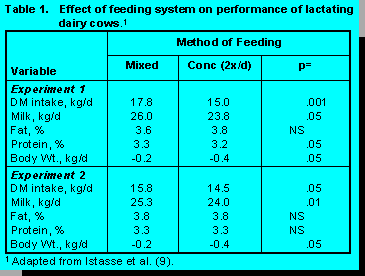 Maintaining normal rumen function and optimizing microbial protein yield is an essential element
of a successful feeding management system. In addition, optimal microbial fermentation also
supports maximum DMI. Rumen fermentation and function are sensitive to pH changes,
especially large decreases associated with excessive starch intake. Rumen acidosis and decreased
intake and performance are common symptoms of herds fed large meals of grain during limited
daily feedings (one to three times a day). Istasse et al. (9) reported cows fed diets containing either
40 or 60% forage dry matter differed in intake and milk production due to feeding method.
Maintaining normal rumen function and optimizing microbial protein yield is an essential element
of a successful feeding management system. In addition, optimal microbial fermentation also
supports maximum DMI. Rumen fermentation and function are sensitive to pH changes,
especially large decreases associated with excessive starch intake. Rumen acidosis and decreased
intake and performance are common symptoms of herds fed large meals of grain during limited
daily feedings (one to three times a day). Istasse et al. (9) reported cows fed diets containing either
40 or 60% forage dry matter differed in intake and milk production due to feeding method. In two studies (Table 1), cows fed concentrates mixed with forages had higher DMI and milk yield with less weight loss compared to cows fed concentrate twice daily with forage fed separate. These changes were associated with decreased apparent digestibility of the diet organic matter. In contrast, Nocek et al. (14) did not observe an effect of method of feeding grain on animal performance. The potential benefits of controlled concentrate feeding include: 1) prevention of ruminal acidosis, 2) improved DMI, and 3) improved milk production. Diets and/or feeding systems that predispose the animals to ruminal acidosis will likely increase the risk of feet and leg problems. Laminitis is associated with the condition of ruminal acidosis. Cows suffering from laminitis tend to spend less time eating due to painful feet and therefore experience decreased DMI and milk production.
Rumen pH can also be affected by forage intake and size of forage particles. Consumption of finely processed forages decreases chewing activity associated with eating and rumination. Beauchemin and Buchanan-Smith (2) investigated the interaction of forage source, particle size, and feeding sequence on digestive function and performance of lactating dairy cows. Cows fed hay prior to concentrate and silage or hay fed mixed with silage had higher intake and milk production compared to cows not receiving long hay (Table 2).
Increased milk production by cows fed hay was associated with changes in rumination activity (Table 2). Increased rumination activity controlled rumen pH changes and increased the extent of alfalfa dry matter disappearance (measured using polyester bags suspended in the rumen). These results illustrate the importance of controlling forage and concentrate intake. In his review, Robinson noted cows have little nutritional wisdom and therefore, feeding systems should limit choice. The feeding system should control intakes of concentrates and forages to maintain normal rumen function, which in turn will optimize intake and maximize milk production.
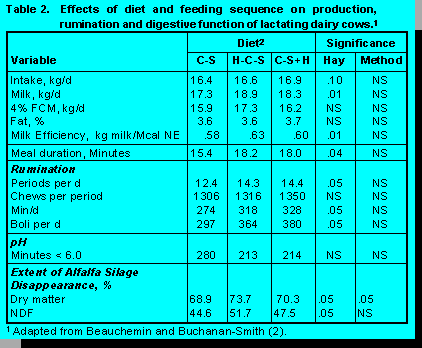
Feed Quality and Intake
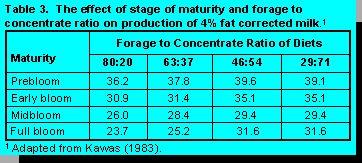 A primary limiting factor controlling intake is the quality of feed fed. This aspect of feeding
management is especially important as it relates to forage quality. Waldo (16) described two
mechanisms that regulate intake; 1) metabolic control, and 2) physical fill. As energy demand for
maintenance and milk production increases, DMI as a percent of body weight also increases.
However, the animal can reach a rumen fill limitation that physically limits the animals' ability to
consume more feed. The primary physical limiting factor as it relates to diet quality is the fiber
content of the forage. Mertens (13) reported a NDF - Energy Intake system that uses neutral
detergent fiber (NDF) content of the diet to describe the intake capacity of the diet (Figure 1). The
primary contributor of NDF in the diet is forage. As NDF increases, the intake of forage decreases.
Feeding poor quality forages not only limits intake, but due to lower intake also reduces milk
production. The results of Kawas (10) illustrated the importance of inventory allocation of forages
by quality to production groups (Table 3). By allocating forage by quality to highest producing
groups of cows, intake and milk production can be optimized. Therefore, feeding systems involve
the allocation of forage by quality to the appropriate production group.
A primary limiting factor controlling intake is the quality of feed fed. This aspect of feeding
management is especially important as it relates to forage quality. Waldo (16) described two
mechanisms that regulate intake; 1) metabolic control, and 2) physical fill. As energy demand for
maintenance and milk production increases, DMI as a percent of body weight also increases.
However, the animal can reach a rumen fill limitation that physically limits the animals' ability to
consume more feed. The primary physical limiting factor as it relates to diet quality is the fiber
content of the forage. Mertens (13) reported a NDF - Energy Intake system that uses neutral
detergent fiber (NDF) content of the diet to describe the intake capacity of the diet (Figure 1). The
primary contributor of NDF in the diet is forage. As NDF increases, the intake of forage decreases.
Feeding poor quality forages not only limits intake, but due to lower intake also reduces milk
production. The results of Kawas (10) illustrated the importance of inventory allocation of forages
by quality to production groups (Table 3). By allocating forage by quality to highest producing
groups of cows, intake and milk production can be optimized. Therefore, feeding systems involve
the allocation of forage by quality to the appropriate production group.
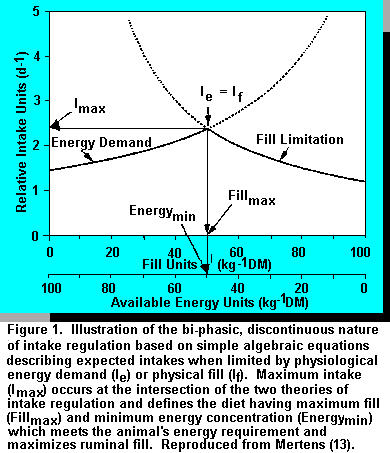
Feeding System Design and Management
The feeding system begins with the feeding area. The question relates to how the feeding system affects the availability of feed, as availability of feed can be a limiting factor in maximizing intake and milk production. Feed access and intake can be influenced by competition for feed and feeding space (1). Friend and Polan (7) reported cows spent almost five hours per day at the feedbunk. The social rank of animals within the group influenced time spent at the bunk after feed was placed in the bunk. Therefore, dominant animals had more opportunity to consume feed first after feeding. Subsequent research reports showed .7 ft per cow would allow adequate access and not depress intake (8). Most current recommendations establish feeding space per cow at 1.5 to 2.0 ft per head. These recommendations agree with the results of feeding behavior research trials.
A more recent report indicated cows selected feeding positions in fenceline feeders based on dominance relationships (11). Cows with the greatest differences in social dominance had average separation of 4.4 feeding positions (2 ft per position). Albright (1) reported cows fed total mixed rations in fenceline feeders ate longer than cows fed in bunks with access around the entire bunk. Feeding system design and layout can potentially impact intake by influencing feed access time via manipulation of animal to animal interactions.
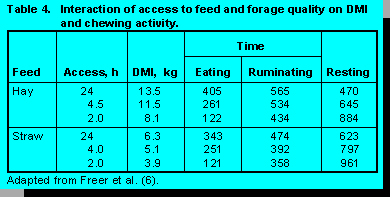 Availability of feed can be a matter of amounts fed and time animals have physical access to eat.
Some herds using ensiled or other wet feeds fail to account for changes in the moisture content of
the feed. A farm feeding 23 kg of corn silage with a dry matter content of 40% would be feeding
9.2 kg of dry matter. However, if over time the silage became wetter with a lower dry matter
content of 30%, feeding 23 kg as fed would only provide 6.9 kg of dry matter from silage. Failure
to adjust the diet for changes in dry matter can lead to underfeeding of the herd. Nutritionists can
describe this situation as the 'slick-bunk syndrome'. This 'syndrome' describes feeding situations
where cows are simply underfed and lick the bunk clean giving it a 'slick' appearance. Freer et al.
(6) observed an interaction of forage quality, feed access time, and DMI (Table 4). These results
indicate intake is influenced by forage quality, possibly forage palatability. This observation is
additional support for forage inventory and allocation by production potential groups.
Availability of feed can be a matter of amounts fed and time animals have physical access to eat.
Some herds using ensiled or other wet feeds fail to account for changes in the moisture content of
the feed. A farm feeding 23 kg of corn silage with a dry matter content of 40% would be feeding
9.2 kg of dry matter. However, if over time the silage became wetter with a lower dry matter
content of 30%, feeding 23 kg as fed would only provide 6.9 kg of dry matter from silage. Failure
to adjust the diet for changes in dry matter can lead to underfeeding of the herd. Nutritionists can
describe this situation as the 'slick-bunk syndrome'. This 'syndrome' describes feeding situations
where cows are simply underfed and lick the bunk clean giving it a 'slick' appearance. Freer et al.
(6) observed an interaction of forage quality, feed access time, and DMI (Table 4). These results
indicate intake is influenced by forage quality, possibly forage palatability. This observation is
additional support for forage inventory and allocation by production potential groups.
More applicable to well managed farms, access to ad lib amounts of high quality feeds should be evaluated. Erdman et al. (5) reported increasing feed access time from 8 h to 20 h increased feed intake from 23.5 kg/d to 24.7 kg/d in midlactation cows. Increased access time did not change milk production and intake as a percent of body weight. Cows with increased feed access time did have higher weight gains which would be important for mid to late lactation cows replacing body condition. Martinsson and Burstedt (12) measured intake and production responses of early lactation cows given access to feed for 8 or 24 h per day. During a two year study, the differences in feed intake were about 1 kg per cow per day. These workers suggested feed access is important especially for early lactation cows. For early lactation cows, this difference would be very important in maintaining body condition and minimizing metabolic disorders during the transition period. This consideration is also a critical point in managing feed access for the dry cow herd.
Water Accessibility
 Water consumption has also been found to influence DMI. Dado and Allen (4) reported a strong
relationship between water intake and milk yield (Pearson correlation coefficient r=.96). A
significant relationship also exists between water intake and DMI. Cows spend less time drinking
than they do eating (Table 5). However, they have more drinking bouts (14) than eating bouts
(11). Comprehensive research on water delivery and management is less complete than feeding
management. Some general guidelines include one station should be provided per 15 cows. The
waterer should allow for free access and should be set so more aggressive cows can not dominate
the waterer. Water should also be available within 50 ft of the feedbunk to help promote feed
intake.
Water consumption has also been found to influence DMI. Dado and Allen (4) reported a strong
relationship between water intake and milk yield (Pearson correlation coefficient r=.96). A
significant relationship also exists between water intake and DMI. Cows spend less time drinking
than they do eating (Table 5). However, they have more drinking bouts (14) than eating bouts
(11). Comprehensive research on water delivery and management is less complete than feeding
management. Some general guidelines include one station should be provided per 15 cows. The
waterer should allow for free access and should be set so more aggressive cows can not dominate
the waterer. Water should also be available within 50 ft of the feedbunk to help promote feed
intake.Feeding Management Summary
Robinson (15) described potential interactions between feeding strategies, feedstuff characteristics, and quality of animal management. Options and possibilities are unlimited for consideration of feeding systems and strategies within a given facility. Within a feeding system, many factors influence DMI. Diet formulation, mixing, and feeding to ensure normal rumen function is a priority for achieving and maintaining intake and productivity. Control of diet ingredient intake is a primary goal of the feeding management system. Feed access contributes to animal performance and success of the feeding program. Palatability of feed or feed quality can stimulate or depress feed intake. Blending and use of feed ingredients with poor palatability should be done carefully to minimize off-feed problems. Maintaining fresh feed during periods of high eating activity (for example after milking) stimulates larger meal sizes as a result of improved palatability. Water supply must be fresh, clean, plentiful, and available to maintain intake and milk production. Feeding management strategies are dynamic from farm to farm. Farm management teams should focus on those factors that influence DMI to achieve and maintain high intakes and animal performance.
Additional Readings
WCDS-1995:
Dry Matter Intake and Milk Production
Applied Dairy Science Course - University of Alberta:
Feeding and Management
Systems to Optimize Milk Production
References
1. Albright, J.L. 1993. Feeding behavior of dairy cattle. J. Dairy Sci. 76:485.
2. Beauchemin, K.A. and J.C. Buchanon-Smith. 1990. Effects of fiber source and method of feeding on chewing activities and productivity of dairy cows. J. Dairy Sci. 73:749.
3. Chase, L.E. 1993. Developing nutrition programs for high producing dairy herds. J. Dairy Sci. 76:3287.
4. Dado R.G. and M.S. Allen. 1994. Variation in and relationships among feeding, chewing and drinking variables for lactating dairy cows. J. Dairy Sci. 77:132.
5. Erdman, R.A., T.W. Moreland and W.R. Stricklin. 1989. Effect of time of feed access on intake and production in lactating dairy cows. J. Dairy Sci. 72:1210.
6. Freer, M. R.C. Campling and C.C. Balch. 1962. Factors affecting the voluntary intake of food by cows. 4. The behavior and reticular motility of cows receiving diets of hay, oat straw and oat straw with urea. Br. J. Nutr. 16:279.
7. Friend, T.H. and C.E. Polan. 1974. Social rank, feeding behavior, and free stall utilization by dairy cattle. J. Dairy Sci. 57:1214.
8. Friend, T.H., C.E. Polan, and M.L. McGilliard. 1977. Free stall and bunk requirements relative to behavior, production and individual feed intake in dairy cows. J. Dairy Sci. 60:108.
9. Istasse, L., G.W. Reid, C.A.G. Tait, and E.R. Orskov. 1986. Concentrates for dairy cows: effects of feeding method, proportion in the diet, and type. Anim. Feed Sci. and Tech. 15:167.
10. Kawas, J.R. 1983. Significance of fiber level on nutritive value of alfalfa hay based diets for ruminants. PhD. Dissertation. University of Wisconsin. Madison, Wisconsin.
11. Manson, F.J. and M.C. Appleby. 1990. Spacing of dairy cows at a food trough. Appl. Anim. Behav. Sci. 26:69.
12. Martinsson, K. and E. Burstedt. 1990. Effects of length of access time to feed and allotment of hay on grass silage intake and production in lactating dairy cows. Swedish J. Agric. Res. 20:169.
13. Mertens, D.R. 1994. Improving intake and performance of forage-based rations. Proc Mid-South Ruminant Nutrition Conference. edited by E.R. Jordan, Texas A and M.
14. Nocek, J.E., R.L. Steele, and D.G. Braund. 1986. Performance of dairy cows fed forage and grain separately versus a total mixed ration. J. Dairy Sci. 69:2140.
15. Robinson, P.H. 1989. Dynamic aspects of feeding management for dairy cows. J. Dairy Sci. 72:1197.
16. Waldo, D.R. 1986. Effect of forage quality on intake and forage-concentrate interactions. J. Dairy Sci. 69:617.